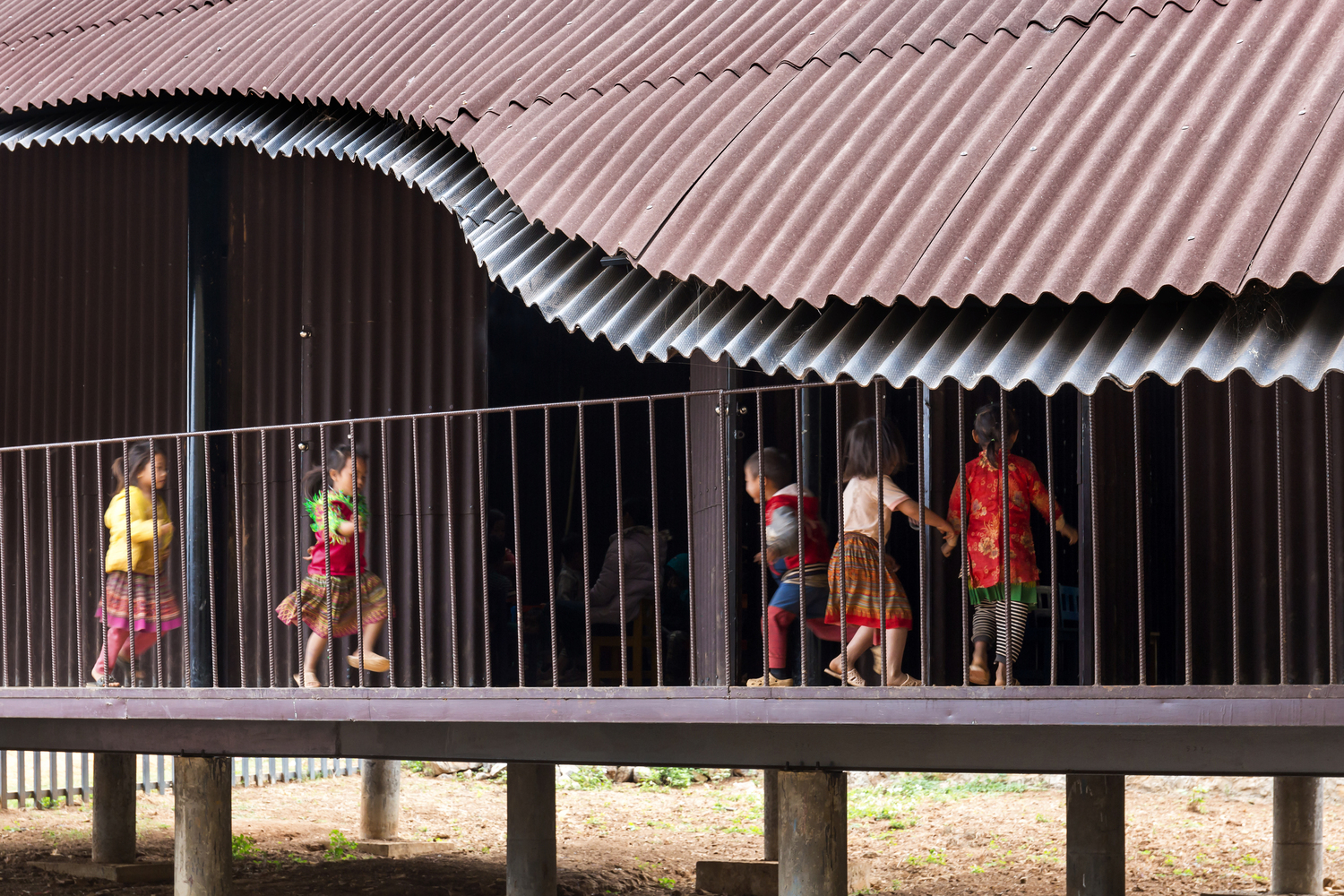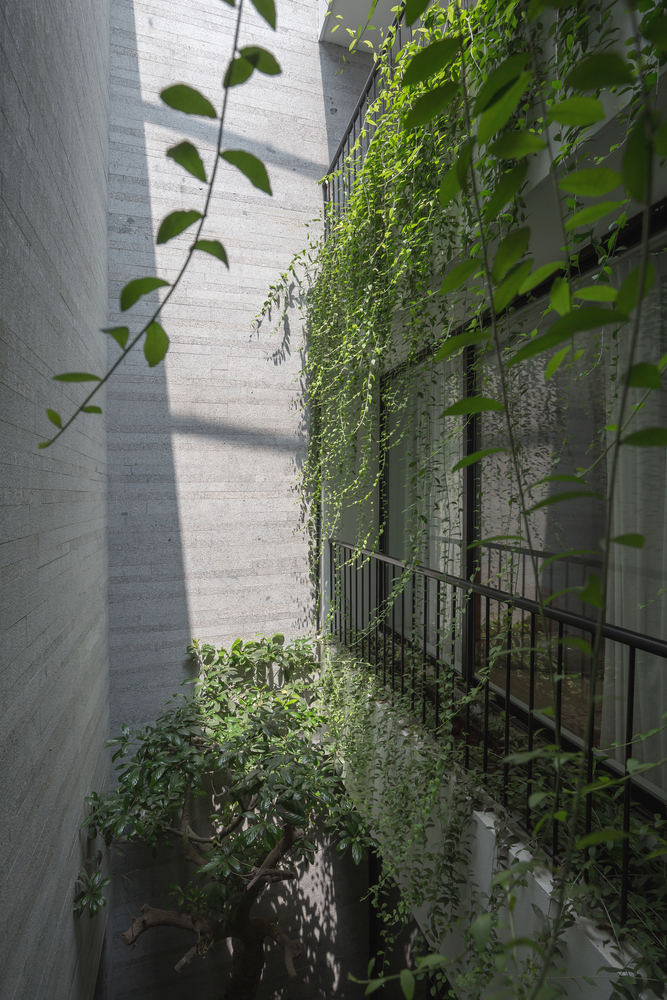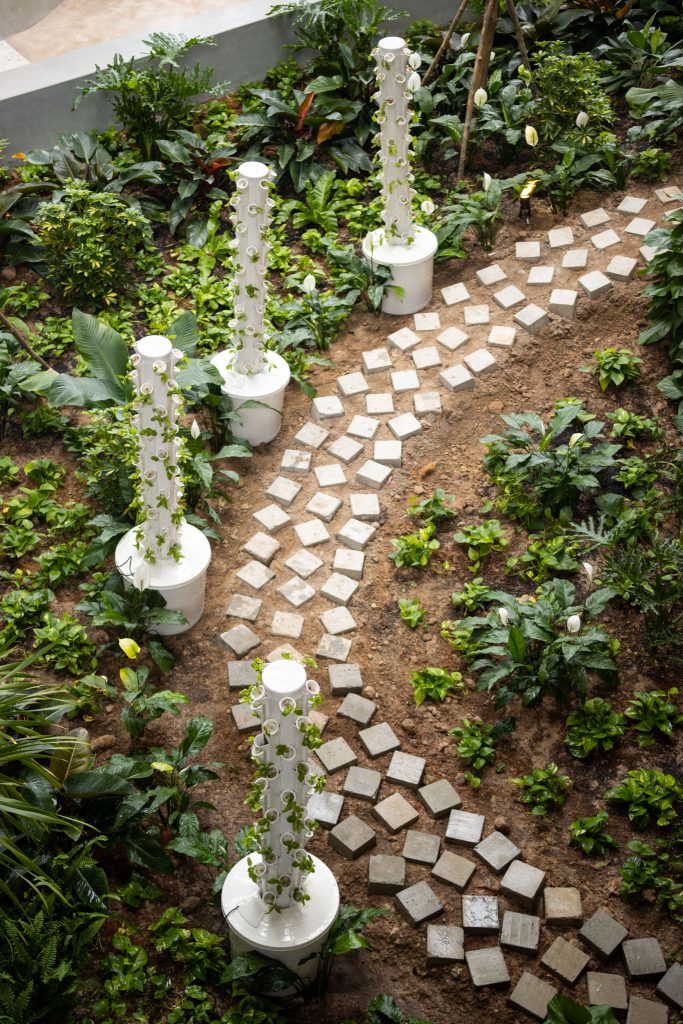Bài viết này có ngôn ngữ Tiếng Việt.
We’ve been exploring Vietnam’s architectural wonders for years. From bamboo homes to vertical gardens, Vietnam has some of the greenest and most innovative sustainable designs in all of South East Asia. For this article, we’re highlighting a few of our favorite sustainable architectural gems across Vietnam that are as kind to the environment, local culture and people, as they are stunning. Get ready for lush rooftop gardens, recycled materials galore, and structures designed to naturally control temperature. Vietnam may be known for its ancient temples and French colonial buildings, but its modern sustainable architecture scene is one of the region’s best-kept secrets. Until now, that is!
Bó Mon Preschool | Son La

Bó Mon Preschool, Son La. Architects: KIENTRUC O. Photo credits: Hoang Le.
Let’s start out trip from up North. We were thrilled to find Bó Mon Preschool during our research, a connecting station for local students tucked away in the mountains of Son La. As if carved from waves of steel, the school’s inhabitants enjoy a smooth transition between sunlight and shade while the structure camouflages itself into the mountains.

The open exterior of Bó Mon Preschool. Architects: KIENTRUC O. Photo credits: Hoang Le.
The dark-colored roof keeps the students warm during cold season, and windows are oriented to catch breeze running down the valley, allowing cross ventilation. Surrounded by an abundance of green, the children have a chance to explore native plants and study in an open-air classroom environment that is rich in natural light.

Bó Mon Preschool, Son La. Architects: KIENTRUC O. Photo credits: Hoang Le.

Bó Mon Preschool, Son La. Architects: KIENTRUC O. Photo credits: Trieu Chien.
Bó Mon Preschool shows how architecture can foster environmental stewardship. Nestled in the mountains, it highlights how humanity and nature can coexist in harmony. The school cultivates our future green citizens by immersing children in ecology, nurturing their bond with the land while makes sure they receive a safe and enriching education.

Bó Mon Preschool, Son La. Architects: KIENTRUC O. Photo credits: Trieu Chien.
Toigetation | Cao Bang

Toigetation, Cao Bang. Architects: H&P ARCHITECTS. Photo credits: Doan Thanh Ha.
Son Lap Commune, Cao Bang mostly consists of the minority ethnic of H’Mong and Dao, who have to live without electricity, infrastructure, or any means of telecommunication. A place where minimum standards of sanitary is still in urgent need, project such as Toigetation comes across as a brilliant solution.

Toigetation, Cao Bang. Architects: H&P ARCHITECTS. Photo credits: Doan Thanh Ha.
A combination of toilet + washing area + vegetation, Toigetation was designed based on three objectives: quick construction, low cost, and widely-applied ability. Made from local resources such as bamboo, brick, and reused sewer; and built by local people including teachers and students, the project can resist natural disasters, provide electricity using solar panels, while reusing waste water and running water.

Toigetation, Cao Bang. Architects: H&P ARCHITECTS. Photo credits: Doan Thanh Ha.

Toigetation, Cao Bang. Architects: H&P ARCHITECTS. Photo credits: Doan Thanh Ha.
With just $3000 of construction cost and a building period of 3 weeks, possible to achieved with local human and material resources, it’s a warm feeling to know that project Toigetation can be seen across Vietnam, helping to improve many lives without taking away parts of local ecology or its unique culture.

Toigetation, Cao Bang. Architects: H&P ARCHITECTS. Photo credits: Doan Thanh Ha.
Multi-generational Townhouse | Hanoi

D House, Hanoi. Architects: ARO Studio. Photo credits: Hoang Le.
Arrived in Hanoi, our research explores innovative takes on classic family house. Known for its tight-knit community and traditions, Hanoians often view their home as a place enjoyed by multi generations. This three-story house was designed for such purpose.
The first generation of the eldest originated as farmers and are used to the practice of agriculture. Hence, the highest level of the house was designed as an open garden that provides home-grown and clean vegetables for the family and neighbors.

D House, Hanoi. Architects: ARO Studio. Photo credits: Hoang Le.
The second generation are the main providers with a busy work-life balance, naturally an environment that helps reduce stress, brings a sense of calm is necessary. Blocks of space allow sun rays to travel from the rooftop down to the lower floors, while plants on the ground grow tall in abundance and density, weaving nature into daily life.

D House, Hanoi. Architects: ARO Studio. Photo credits: Hoang Le.

D House, Hanoi. Architects: ARO Studio. Photo credits: Hoang Le.
This harmony opens opportunities for the youngest generation to stay motivated and encouraged them to play and explore freely without the interference of technology.

D House, Hanoi. Architects: ARO Studio. Photo credits: Hoang Le.
A self-cooling, flood-proof architecture, a space that reignites family connections, and a self-sufficient lifestyle that cultivates own fresh supplies; by using readily available, renewable materials and clever design, this multi-generational townhouse in Hanoi is a bright example of adapting to rapid urbanization without changing roots.

D House, Hanoi. Architects: ARO Studio. Photo credits: Hoang Le.
Pizza 4P’s Hikari | Binh Duong

PIZZA 4P’S Hikari, Binh Duong. Architects: Takashi Niwa Architects. Photo credits: PIZZA 4P’S.
Choosing their first “zero waste” concept in Vietnam at Hikari Complex, Binh Duong, Pizza 4P’s continues to keep the idea of being environmentally friendly in mind, incorporating composting, aquaponics, and edible landscapes into their new location.

PIZZA 4P’S Hikari, Binh Duong. Architects: Takashi Niwa Architects. Photo credits: PIZZA 4P’S.

PIZZA 4P’S Hikari, Binh Duong. Architects: Takashi Niwa Architects. Photo credits: PIZZA 4P’S.
Following their Earth to People ethos, the restaurant caters moments of mindfulness in a natural setting while bringing home their win of The Green GOOD DESIGN Sustainability Awards. Slowly and steadily, Pizza 4P’s has become one the best known names in Vietnam’s sustainable development scene.

PIZZA 4P’S Hikari, Binh Duong. Architects: Takashi Niwa Architects. Photo credits: PIZZA 4P’S.
Urban Farming Office | Ho Chi Minh

Urban Farming Office, Ho. Architects: VTN Architects. Photo credits: Hiroyuki Oki.
Another example of integrating nature into the rapid urbanization scene. According to the architects of the project: ‘… cities in Vietnam have diverged far from their origins as sprawling tropical forests. The lack of green causes various social problems such as air pollution due to the over-abundance of motorbikes, air pollution, flood, and the heat island effect.’ Understanding the assignment at hand, Urban Farming Office was created as an effort to improve the situation.

Urban Farming Office, Ho. Architects: VTN Architects. Photo credits: Hiroyuki Oki.

Urban Farming Office, Ho. Architects: VTN Architects. Photo credits: Hiroyuki Oki.
A modern workplace with a ‘vertical farm’ system seen from upfront, the inhabitants here enjoy a naturally-filtered air and self-cooling environment throughout the building. When seen up close, concrete plant boxes reveal themselves including various local finds of vegetables, herbs and fruit trees. Each box is replaceable and rearranged accordingly when they reach a certain height and the different amount of sunlight they need to flourish. Combined with a roof garden and ground, the system is said to provide up to 190% of the green ratio of the area, equivalent to 1.1 tons of harvest.

Urban Farming Office, Ho. Architects: VTN Architects. Photo credits: Hiroyuki Oki.

Urban Farming Office, Ho. Architects: VTN Architects. Photo credits: Hiroyuki Oki.
Forward-thinking projects like the Urban Farming Office point the way to a greener future for Vietnam. Smartly converting unused rooftop space into green space is an easy way for companies to operate more sustainably, give back to the community, and boost employee well-being. We hope more sustainable architectural marvels will continue to sprout up across this tropical country.

Urban Farming Office, Ho. Architects: VTN Architects. Photo credits: Hiroyuki Oki.

Urban Farming Office, Ho. Architects: VTN Architects. Photo credits: Hiroyuki Oki.
We’re here, at the end of our trip. We hope this quick tour of some of Vietnam’s most eco-friendly architectural marvels has inspired you. There’s clearly an exciting sustainable design movement happening in this beautiful country, with local architects and international firms pushing the envelope of green building innovation. From passive cooling to renewable energy to reclaimed and recycled materials, these buildings showcase the range of strategies that can be employed to reduce environmental impact. Vietnam may be developing rapidly, but it’s encouraging to see a commitment to sustainable growth and a flourishing green building sector taking shape. The future looks bright green!
In the following articles, we’ll be exploring this topic in detailed and region-focused perspective. We welcome your visit to our blog anytime. If you have a project or an idea that you’d like to suggest to us, let’s hear it!
